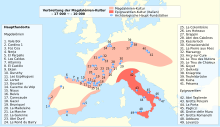Swiss image
Coordinates: 47 ° 43 '25.3 " N , 8 ° 38' 28" E ; CH1903: 690220 / 286592
Schweizersbild is the name of a prehistoric site in the Herblingen district of the city of Schaffhausen in Switzerland . The paleolithic site is now on the edge of an industrial zone near the Schweizersbild exit on the A4 national road . It belongs to the Canton of Schaffhausen and is in the federal inventory of landscapes and natural monuments of national importance .
Surname
The name Schweizersbild is traced back to the foundation of a Schaffhausen citizen named Schwytzer. In the Middle Ages he had a house built around an image of a saint. Over time, the name Schwytzers was transferred to the rocks. The house was demolished in the 19th century.
Abri
The Abri is located near a spring at the foot of two prominent rock heads. The protection is formed by a 16 meter high rock wall. The protruding rock roof, under which the hunters could pitch their tents, still covers 60 m² today. The forests crossed by streams were rich in game.
discovery
Jakob Nüesch discovered the former camp site of reindeer hunters in 1891. Between 1891 and 1893 he carried out excavations. Significant traces of settlement were found from the Magdalenian period , a more recent section of the Upper Palaeolithic , around 12,000 years BC. Chr.
In 1895 August Hedinger published the results of geological studies of prehistoric artifacts of the Swiss image , they appeared as a memorandum of the Swiss Friends of Nature Society .
Digs
As in the nearby Kesslerloch , numerous bone and stone tools, waste from antler and flint processing as well as pieces of jewelry came to light. The top layer consisted of post-glacial finds (including Neolithic graves ). This was followed by a largely artifact-free rodent layer over ice-age gravel. There were leftovers u. a. found from the arctic fox , reindeer , wild horse , mountain hare and a rib fragment of a woolly rhinoceros . The lower jaw of a rhinoceros was found in the limestone quarries near Flurlingen .
A child's grave, a fireplace, a flint site and several hundred flint tools were found on human artefacts . Next were cusps , devices made of bone and antler as projectile points, harpoons , chisel , hole rods , needles and jewelry excavated. Some finds are exhibited in the Museum zu Allerheiligen in Schaffhausen.
Ice age art
Hole stick with two wild horses following each other ( National Museum Zurich )
stylized female figure from Gagat (copy, original in the Museum der Kulturen Basel )

The Swiss picture site became known for its finds of Ice Age art ; the incised drawings and sculptures are typical of the Magdalenian culture (16,000 to 13,000 BC). The engravings differ from the works of art found in the Kesslerloch in that they are more stylized. It is worth mentioning a small female statuette made of gagat , a form of petrified coal. The statue was discovered by chance in the excavation of the excavations as a reading find .
Climbing rock
The rocks are climbed by climbers. The 19 routes in steep limestone also offer passages with fine ridges and tricky standing problems.
fauna and Flora
In 2009 a gentle thinning of the trees and bushes began. Better tanning in this dry location promotes biodiversity. The image of Switzerland offers an ideal habitat, especially for warmth-loving and rather rare animal and plant species such as lizards and pasque flowers .
literature
- Markus Höneisen: Swiss image . In: Historical Lexicon of Switzerland .
- Schaffhauser Nachrichten, Schaffhausen, July 25, 2009
- Markus Höneisen and Sabine Peyer: Swiss picture - A hunter camp of the late ice age. Articles and documents on the excavation 100 years ago after 1994. ISBN 3-907066-06-5









